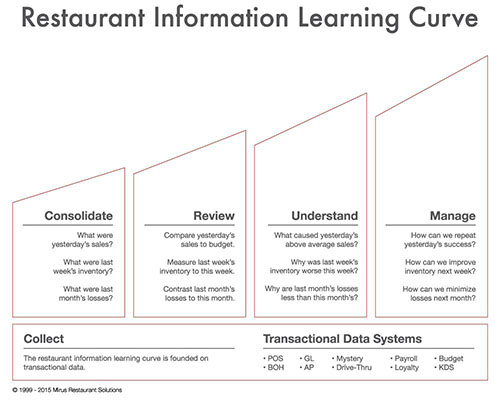
3 Reasons Why Operators Should Mind (and Mine) Their Big Data (Part 2 of 2)
04 August 2015To fully harness the power of restaurant information, operators must first identify where they are on the learning curve and then plot a course to progress along it. While most operators aren’t behind the curve compared to their competition just yet, the landscape is changing, and playing offense is better than defense.
By Dave Bennett
Have you ever driven a car with a box over your head, with only a peephole through which to see? Of course not—you couldn’t see where you want to go. And yet, some chain-restaurant operators are doing just that: driving their businesses while looking at only small amounts of information.
As an automobile driver, you want to see clearly out of your windshield, side windows and rear-view mirror so you have all the information you need to make smart driving decisions. Similarly, chain leaders should want a clear view of their operations, looking back and forward, so that they can make smart business decisions.
The first article in this series presented two of three reasons why restaurant operators should mind—or perhaps more aptly, to mine—their operations’ Big Data:
1. Information is power. Harnessing restaurant information can increase earnings and grow the business.
2. That power is within reach.Real management power comes when operators begin to Consolidate and Review all their data, so that they can better Understand and Manage their businesses. Those are the four stages of the Restaurant Information Learning Curve, as depicted in the following graphic:
And now, here is the third reason operators should harness their data:
3. Offense is better than defense.To fully harness the power of restaurant information, operators must first identify where they are on the learning curve and then plot a course to progress along it. The good news is that most operators aren’t behind the curve compared to their competition just yet. But the landscape is changing, and playing offense is better than defense.
Plenty of large, 1,500+ unit chains are low on the learning curve. So are many 30-, 40- and 80-unit operators. (“Low” is defined as the “Consolidate” to “Review” stages of the curve.) I estimate that 10% to 15% of chain operations are in the “Consolidate” stage, while 60% to 70% are somewhere in the “Review” stage.
Companies that are on the low end of the learning curve tend to put value on past experience; what worked yesterday is good enough for today. They play defense rather than offense. And they will continue on that way for as long as the marketplace lets them. Meanwhile, companies in the “Understand” and “Manage” stage are innovators—and leaders.
Proactivity Pays Off
What’s the incentive for an operator to proactively move up the learning curve? After all, that requires time and money, both of which are often tight in the foodservice industry.
Many things can nudge companies to embrace their data: lagging performance, fresh competition or new and more aggressive ownership. Most of these companies will likely first look at a menu refresh and/or store remodeling. Eventually, they also get pushed to move up the learning curve.
The benefit of moving up the curve is that by having more information, operators can take action sooner. Simply put, you can do more when you know more.
And that benefit is quantifiable. My observation is that a company that moves from the “Review” to the “Understand” stage gains 1% to 2% on its bottom line. Their traffic can be 4% to 5% better. Our clients’ quarterly same-store sales outperform industry norms by 1% to 3%, sometimes even more. That is real, bottom-line value.
More Information Is Better
When a business is low on the learning curve, one challenge is that the questions it can answer are limited. For example, most transactional systems focus on what happened at a point in time, such as yesterday or last week. When looking at such simplified data, operators can only answer simple questions, such as how last week compared to the same week last year.
Companies that are moving from the “Review” to “Understand” stages of the curve analyze their data against predefined benchmarks. Now they can tell whether yesterday helped or hurt them versus their budget goals. The advantage of evaluating against a yardstick is that smart operators will know sooner whether something is happening, bad or good—and they can respond quicker.
Most of my company’s clients are in the “Understand” stage; a few are peeking over the hedge at the “Manage” stage. These companies are moving into Big Data analysis, looking at much more information and in a more sophisticated way. They are looking beyond the numbers, to find the reasons behind them. They can ask questions such as, Is our failure to achieve budget consistent across all markets, all dayparts, all menu parts? Is traffic down, or our customers spending less than they used to? What happened when we stopped advertising, or when a new competitor entered the market?
Companies in the “Understand” and “Manage” stages regularly toss up a huge amount of information, looking for the needles in the haystacks. They know that when they sell one menu item, they also sell another. Their data told them when it was time to revise their menus, and when it was time to revamp their kitchens—and they see the results, in higher earnings and better bottom lines.
Help Is Available
More good news: Operators don’t have to tackle the learning curve alone. Help is available, from quality vendors who have made Big Data their lives’ work. We admit it, we are geeks who live for and love this stuff.
I advise operators to take their time to research and interview service providers. I tell them to seek out vendors that will truly become business partners, who won’t just close a sales deal and move on. Look beyond transactional systems that simply collect data, to enterprise systems to help interpret data. Request a customer list, not just references. Inquire how long customers stay with them. Ask vendors who will own the data (see sidebar).
Looking into the Future
Fifteen years ago, most restaurant-chain operators didn’t understand why they needed anything more than their transactional systems and the data they provide. Today the conversation is moving beyond collecting basic transactional data to assimilating data from across all systems and interpreting that data to make better business decisions.
Looking into the future another 15 years, the chains that have harnessed the power of their Big Data will be the industry’s top performers. And the operators leading those chains will be the ones who prefer to explore the road ahead, rather than look in the rear view.
Dave Bennett is CEO of Mirus Restaurant Solutions, a pioneer in cloud-based restaurant reporting and analysis systems before the cloud was cool. He has more than 30 years of experience in restaurant technology and information management. This is the second article in a two-part series. Read the first article here. Bennett has also written for “Gold Medal Classroom” about restaurant-data basics; read that article here.
